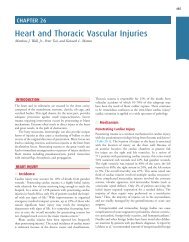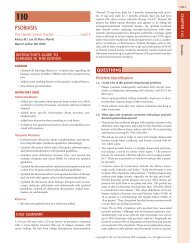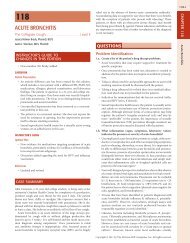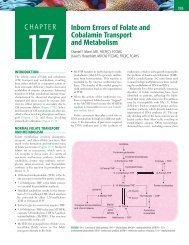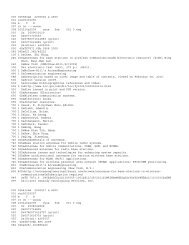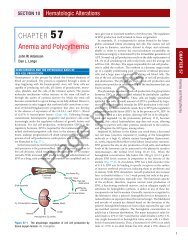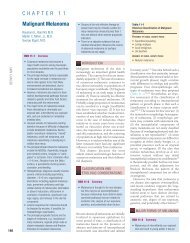Gemba Kaizen
Gemba Kaizen
Gemba Kaizen
You also want an ePaper? Increase the reach of your titles
YUMPU automatically turns print PDFs into web optimized ePapers that Google loves.
<strong>Gemba</strong><br />
<strong>Kaizen</strong><br />
TM<br />
second edition<br />
a Commonsense approaCh to a<br />
Continuous improvement strateGy<br />
Masaaki Imai
CHAPTER ONE<br />
An Introduction to <strong>Kaizen</strong><br />
Since 1986 when the book <strong>Kaizen</strong>: The Key to Japan’s Competitive Success<br />
was published, the term kaizen has come to be accepted as one of the key<br />
concepts of management. In the first decade of the twenty-first century as<br />
the Toyota Motor Company surpassed General Motors to become the top<br />
automotive manufacturer in the world, awareness of the vital difference<br />
played by kaizen in Toyota’s success also increased.<br />
Today, organizations worldwide from manufacturers, to hospitals, to<br />
banks, to software developers, to governments are making a difference by<br />
adopting kaizen philosophies, mind-sets, and methodologies. Even though<br />
the names of these strategies may change over the decades from continuous<br />
quality improvement and total quality management, to just-in-time and<br />
operational excellence, to six sigma and lean manufacturing, the most<br />
successful of these strategies are customer-focused, gemba-oriented, and<br />
kaizen-driven.<br />
The 1993 edition of the New Shorter Oxford English Dictionary<br />
recognized the word kaizen* as an English word. The dictionary defines<br />
kaizen as “continuous improvement of working practices, personal effi -<br />
ciency, etc., as a business philosophy.” Readers who are unfamiliar with<br />
kaizen may find it helpful to begin with a brief summary of the concepts of<br />
kaizen. For those who are already familiar with kaizen, this chapter may<br />
serve as a review.<br />
In Japanese, kaizen means “continuous improvement.” The word implies<br />
improvement that involves everyone—both man agers and workers—and<br />
entails relatively little expense. The kaizen philosophy assumes that our way<br />
*<strong>Kaizen</strong> Institute AG has exclusive right to the use of kaizen ® , as well as gemba kaizen ® , as<br />
trademarks registered in major countries of the world.<br />
1
2 | Chapter 1 An Introduction to <strong>Kaizen</strong><br />
of life—be it our work ing life, our social life, or our home life—should focus<br />
on con stant improvement efforts. This concept is so natural and obvi ous to<br />
many Japanese that they don’t even realize they possess it! In my opinion,<br />
kaizen has contributed greatly to Japan’s competitive success.<br />
Although improvements under kaizen are small and incre mental, the<br />
kaizen process brings about dramatic results over time. The kaizen concept<br />
explains why companies cannot remain static for long in Japan. Western<br />
management, mean while, worships innovation: major changes in the wake<br />
of tech nological breakthroughs and the latest management concepts or<br />
production techniques. Innovation is dramatic, a real attention-getter.<br />
<strong>Kaizen</strong>, on the other hand, is often undramatic and subtle. But innovation<br />
is one- shot, and its results are often prob lematic, whereas the kaizen<br />
process, based on commonsense and low -cost approaches, ensures<br />
incremental progress that pays off in the long run. <strong>Kaizen</strong> is also a low- risk<br />
approach. Managers always can go back to the old way without incurring<br />
large costs.<br />
Most “uniquely Japanese” management practices, such as total quality<br />
control (TQC) or companywide quality control and quality circles, and our<br />
style of labor relations can be reduced to one word: kaizen. Using the term<br />
kaizen in place of such buzzwords as productivity, total quality control<br />
(TQC), zero defects (ZDs), just- in- time (JIT), and the suggestion system<br />
paints a clearer picture of what has been going on in Japanese industry.<br />
<strong>Kaizen</strong> is an umbrella concept for all these practices. However, I has ten to<br />
add that these practices are not necessarily confined to Japanese<br />
management but rather should be regarded as sound principles to be<br />
applied by managers everywhere. By following the right steps and applying<br />
the processes properly, any compa ny, no matter what its nationality, can<br />
benefit from kaizen. The widespread acceptance of kaizen into management<br />
thinking, including the successes of <strong>Kaizen</strong> Institute clients in more than<br />
50 countries, bears this out.<br />
Major <strong>Kaizen</strong> Concepts<br />
Management must learn to implement certain basic concepts and systems<br />
in order to realize kaizen strategy:<br />
▲ <strong>Kaizen</strong> and management<br />
▲ Process versus result
Major <strong>Kaizen</strong> Concepts | 3<br />
▲ Following the plan- do-check-act (PDCA)/standardize-do-check-act<br />
(SDCA) cycles<br />
▲ Putting quality first<br />
▲ Speak with data.<br />
▲ The next process is the customer.<br />
By way of introduction, top management must put forth a very careful<br />
and very clear policy statement. It then must establish an implementation<br />
schedule and demonstrate lead ership by practicing a kaizen procedure<br />
within its own ranks.<br />
<strong>Kaizen</strong> and Management<br />
In the context of kaizen, management has two major functions: mainten -<br />
ance and improvement (see Figure 1.1). Maintenance refers to activities<br />
directed toward maintaining current techno logical, managerial, and<br />
operating standards and upholding such standards through training and<br />
discipline. Under its maintenance function, management performs its<br />
assigned tasks so that everybody can follow standard operating proce dures<br />
(SOPs). Improvement, meanwhile, refers to activities directed toward<br />
elevating current standards. The Japanese view of management thus boils<br />
down to one precept: Maintain and improve standards.<br />
As Figure 1. 2 shows, improvement can be classified as either kaizen or<br />
innovation. <strong>Kaizen</strong> signifies small improve ments as a result of ongoing<br />
efforts. Innovation involves a drastic improvement as a result of a large<br />
investment of resources in new technology or equipment. (Whenever<br />
money is a key fac tor, innovation is expensive.) Because of their fascination<br />
Top management<br />
Middle management<br />
Supervisors<br />
Workers<br />
Improvement<br />
Maintenance<br />
Figure 1.1 Japanese perceptions of job functions.
4 | Chapter 1 An Introduction to <strong>Kaizen</strong><br />
Top management<br />
Middle management<br />
Supervisors<br />
Workers<br />
Figure 1.2 Improvement broken down into innovation and kaizen.<br />
with innovation, Western managers tend to be impatient and over look the<br />
long -term benefits kaizen can bring to a company. <strong>Kaizen</strong>, on the other<br />
hand, emphasizes human efforts, morale, communication, training,<br />
teamwork, involvement, and self -dis cipline—a commonsense, low- cost<br />
approach to improvement.<br />
Process versus Result<br />
Innovation<br />
<strong>Kaizen</strong><br />
<strong>Kaizen</strong> fosters process- oriented thinking because processes must be<br />
improved for results to improve. Failure to achieve planned results indicates<br />
a failure in the process. Management must identify and correct such<br />
process- based errors. <strong>Kaizen</strong> focuses on human efforts—an orientation that<br />
contrasts sharply with the results- based thinking in the West.<br />
A process-oriented approach also should be applied in the intro -<br />
duction of the various kaizen strategies: the plan- do-check-act (PDCA)<br />
cycle; the standardize-do-check-act (SDCA) cycle; quality, cost, and<br />
delivery (QCD); total quality manage ment (TQM); just-in-time (JIT); and<br />
total productive maintenance (TPM). <strong>Kaizen</strong> strategies have failed many<br />
companies simply because they ignored process. The most crucial element<br />
in the kaizen pro cess is the commitment and involvement of top man -<br />
agement. It must be demonstrated immediately and consistent ly to ensure<br />
success in the kaizen process.<br />
Following the PDCA/SDCA Cycles<br />
Maintenance<br />
The first step in the kaizen process establishes the plan- do- check-act (PDCA)<br />
cycle as a vehicle that ensures the continu ity of kaizen in pursuing a policy
Act<br />
Check<br />
Improvement<br />
A P<br />
C D<br />
Figure 1. 3 The plan- do- check- act (PDCA) cycle.<br />
Major <strong>Kaizen</strong> Concepts | 5<br />
Plan<br />
of maintaining and improving standards. It is one of the most important<br />
concepts of the process (see Figure 1. 3).<br />
Plan refers to establishing a target for improvement (since kaizen is a<br />
way of life, there always should be a target for improvement in any area)<br />
and devising action plans to achieve that target. Do refers to implementing<br />
the plan. Check refers to determining whether the implementation remains<br />
on track and has brought about the planned improvement. Act refers to<br />
performing and standardizing the new procedures to prevent recurrence of<br />
the original problem or to set goals for the new improvements. The PDCA<br />
cycle revolves continuously; no sooner is an improvement made than the<br />
resulting status quo becomes the target for further improvement. PDCA<br />
means never being satisfied with the status quo. Because employees prefer<br />
the status quo and frequently do not have initiative to improve conditions,<br />
management must initiate PDCA by establishing continuously challenging<br />
goals.<br />
In the beginning, any new work process is unstable. Before one starts<br />
working on PDCA, any current process must be sta bilized in a process often<br />
referred to as the standardize- do- check- act (SDCA) cycle (see Figure 1. 4).<br />
Every time an abnormality occurs in the current process, the following<br />
questions must be asked: Did it happen because we did not have a standard?<br />
Do
6 | Chapter 1 An Introduction to <strong>Kaizen</strong><br />
Act<br />
Check<br />
Figure 1 .4 The standardize- do- check- act (SDCA) cycle.<br />
Did it happen because the stan dard was not followed? Or did it happen<br />
because the standard was not adequate? Only after a standard has been<br />
established and followed, stabilizing the current process, should one move<br />
on to the PDCA cycle.<br />
Thus the SDCA cycle standardizes and stabilizes the current process es,<br />
whereas the PDCA cycle improves them. SDCA refers to maintenance, and<br />
PDCA refers to improvement; these become the two major responsibilities<br />
of management.<br />
Putting Quality First<br />
Maintenance<br />
A S<br />
C D<br />
Standardize<br />
Of the primary goals of quality, cost, and delivery (QCD), quality always<br />
should have the highest priority. No matter how attrac tive the price and<br />
delivery terms offered to a customer, the company will not be able to<br />
compete if the product or service lacks quality. Practicing a quality -first<br />
credo requires manage ment commitment because managers often face the<br />
tempta tion to make compromises in meeting delivery requirements or<br />
cutting costs. In so doing, they risk sacrificing not only quality but also the<br />
life of the business.<br />
Do
Speak with Data<br />
<strong>Kaizen</strong> is a problem -solving process. In order for a problem to be correctly<br />
understood and solved, the problem must be recog nized and the relevant<br />
data gathered and analyzed. Trying to solve a problem without hard data is<br />
akin to resorting to hunch es and feelings—not a very scientific or objective<br />
approach. Collecting data on the current status helps you to understand<br />
where you are now focusing; this serves as a starting point for improvement.<br />
Collecting, verifying, and analyzing data for improvement is a theme that<br />
recurs throughout this book.<br />
The Next Process Is the Customer<br />
All work is a series of processes, and each process has its sup plier as well as<br />
its customer. A material or a piece of informa tion provided by process A<br />
(supplier) is worked on and improved in process B and then sent on to<br />
process C. The next process always should be regarded as a customer. The<br />
axiom “the next process is the customer” refers to two types of customers:<br />
internal (within the company) and external (out in the market).<br />
Most people working in an organization deal with internal customers.<br />
This realization should lead to a commitment never to pass on defective<br />
parts or inaccurate pieces of information to those in the next process. When<br />
everybody in the organiza tion practices this axiom, the external customer<br />
in the market receives a high -quality product or service as a result. A real<br />
quality- assurance system means that everybody in the organiza tion<br />
subscribes to and practices this axiom.<br />
Major <strong>Kaizen</strong> Systems<br />
Major <strong>Kaizen</strong> Systems | 7<br />
The following are major systems that should be in place in order to<br />
successfully achieve a kaizen strategy:<br />
▲ Total quality control (TQC)/total quality management (TQM)<br />
▲ A just -in- time (JIT) production system (Toyota Production System)<br />
▲ Total productive maintenance (TPM)<br />
▲ Policy deployment<br />
▲ A suggestion system<br />
▲ Small -group activities
8 | Chapter 1 An Introduction to <strong>Kaizen</strong><br />
Total Quality Control/Total Quality Management<br />
One of the principles of Japanese management has been total quality<br />
control (TQC), which, in its early development, empha sized control of the<br />
quality process. This has evolved into a sys tem encompassing all aspects of<br />
management and is now referred to as total quality management (TQM), a<br />
term used internationally.<br />
Regarding the TQC/TQM movement as a part of kaizen strategy gives<br />
us a clearer understanding of the Japanese approach. Japanese TQC/TQM<br />
should not be regarded strictly as a quality-control activity; TQC/TQM has<br />
been developed as a strategy to aid management in becoming more<br />
competitive and profitable by helping it to improve in all aspects of busi ness.<br />
In TQC/TQM, Q, meaning “quality,” has priority, but there are other goals,<br />
too—namely, cost and delivery.<br />
The T in TQC/TQM signifies “total,” meaning that it involves everybody<br />
in the organization, from top management through middle managers,<br />
supervisors, and shop-floor workers. It fur ther extends to suppliers, dealers,<br />
and wholesalers. The T also refers to top management’s leadership and<br />
performance—so essential for successful implementation of TQC/TQM.<br />
The C refers to “control” or “process control.” In TQC/TQM, key<br />
processes must be identified, controlled, and improved on continuously in<br />
order to improve results. Management’s role in TQC/TQM is to set up a<br />
plan to check the process against the result in order to improve the process,<br />
not to criticize the process on the basis of the result.<br />
TQC/TQM in Japan encompasses such activities as policy deployment,<br />
building quality-assurance systems, standardization, training and education,<br />
cost management, and quality circles.<br />
The Just- in-Time Production System<br />
Originating at Toyota Motor Company under the leadership of Taiichi<br />
Ohno, the just- in- time (JIT) production system aims at eliminating nonvalue-<br />
adding activities of all kinds and achiev ing a lean production system<br />
that is flexible enough to accommodate fluctuations in customer orders.<br />
This production system is supported by such concepts as takt time (the time<br />
it takes to produce one unit) versus cycle time, one -piece flow, pull pro -<br />
duction, jidoka (“autonomation”), U-shaped cells, and setup reduction.
To realize the ideal JIT production system, a series of kaizen activities<br />
must be carried out continuously to elimi nate non-value- adding work in<br />
gemba. JIT dramatically reduces cost, delivers the product in time, and<br />
greatly enhances compa ny profits.<br />
Total Productive Maintenance<br />
An increasing number of manufacturing companies now prac tice total<br />
productive maintenance (TPM) within as well as outside of Japan. Whereas<br />
TQM emphasizes improving overall management performance and quality,<br />
TPM focuses on improving equipment quality. TPM seeks to maximize<br />
equip ment efficiency through a total system of preventive mainte nance<br />
spanning the lifetime of the equipment.<br />
Just as TQM involves everybody in the company, TPM involves every -<br />
body at the plant. The five S of housekeeping (discussed in Chapter 5),<br />
another pivotal activity in gemba, may be regarded as a prelude to TPM.<br />
However, 5 S activi ties have registered remarkable achievements in many<br />
cases even when carried out separately from TPM.<br />
Policy Deployment<br />
Major <strong>Kaizen</strong> Systems | 9<br />
Although kaizen strategy aims at making improvements, its impact may be<br />
limited if everybody is engaged in kaizen for kaizen’s sake without any aim.<br />
Management should establish clear targets to guide everyone and make<br />
certain to provide leadership for all kaizen activities directed toward<br />
achieving the targets. Real kaizen strategy at work requires closely supervised<br />
implementation. This process is called Policy Deployment, or in Japanese,<br />
hoshin kanri.<br />
First, top management must devise a long- term strategy, broken down<br />
into medium- term and annual strategies. Top management must have a<br />
plan-to-deploy strategy, passing it down through subsequent levels of<br />
management until it reaches the shop floor. As the strategy cascades down<br />
to the lower echelons, the plan should include increasingly specific action<br />
plans and activities. For instance, a policy statement along the lines of “We<br />
must reduce our cost by 10 percent to stay competitive” may be translated<br />
on the shop floor to such activities as increasing productivity, reducing<br />
inventory and rejects, and improving line configurations.
10 | Chapter 1 An Introduction to <strong>Kaizen</strong><br />
<strong>Kaizen</strong> without a target would resemble a trip without a destination.<br />
<strong>Kaizen</strong> is most effective when everybody works to achieve a target, and<br />
management should set that target.<br />
The Suggestion System<br />
The suggestion system functions as an integral part of individ ual-oriented<br />
kaizen and emphasizes the morale- boosting bene fits of positive employee<br />
participation. Japanese managers see its primary role as that of sparking<br />
employee interest in kaizen by encouraging them to provide many<br />
suggestions, no matter how small. Japanese employees are often encouraged<br />
to discuss their suggestions verbally with supervisors and put them into<br />
action right away, even before submitting suggestion forms. They do not<br />
expect to reap great economic benefits from each suggestion. Developing<br />
kaizen -minded and self-disciplined employees is the primary goal. This<br />
outlook contrasts sharply with that of Western management’s emphasis on<br />
the economic benefits and financial incentives of suggestion systems.<br />
Small -Group Activities<br />
A kaizen strategy includes small -group activities—informal, voluntary,<br />
intracompany groups organized to carry out specific tasks in a workshop<br />
environment. The most popular type of small- group activity is quality<br />
circles. Designed to address not only quality issues but also such issues as<br />
cost, safety, and pro ductivity, quality circles may be regarded as grouporiented<br />
kaizen activities. Quality circles have played an important part in<br />
improving product quality and productivity in Japan. However, their role<br />
often has been blown out of proportion by overseas observers, who believe<br />
that these groups are the mainstay of quality activities in Japan.<br />
Management plays a leading role in realizing quality—in ways that include<br />
building quality-assurance systems, providing employee training, estab -<br />
lishing and deploying policies, and building cross -functional systems for<br />
QCD. Successful quality-circle activities indicate that management plays an<br />
invisible but vital role in supporting such activities.
The Ultimate Goal of <strong>Kaizen</strong> Strategy | 11<br />
The Ultimate Goal of <strong>Kaizen</strong> Strategy<br />
Since kaizen deals with improvement, we must know which aspects of<br />
business activities need to be improved most. And the answer to this<br />
question is quality, cost, and delivery (QCD). My previous book, <strong>Kaizen</strong>:<br />
The Key to Japan’s Competitive Success, used the term quality, cost, and<br />
scheduling (QCS). Since that time, QCD has replaced QCS as the commonly<br />
accepted terminology.<br />
Quality refers not only to the quality of finished products or services but<br />
also to the quality of the processes that go into those products or services.<br />
Cost refers to the overall cost of designing, producing, selling, and servicing<br />
the product or ser vice. Delivery means delivering the requested volume on<br />
time. When the three conditions defined by the term QCD are met,<br />
customers are satisfied.<br />
QCD activities bridge such functional and departmental lines as<br />
research and development, engineering, production, sales, and after-sales<br />
service. Therefore, cross -functional col laborations are necessary, as are<br />
collabo rations with suppliers and dealers. It is top management’s responsi -<br />
bility to review the current position of the company’s QCD in the market -<br />
place and to establish priorities for its QCD improvement policy.<br />
Following the chapters of this book, I have assembled a number of cases<br />
that illustrate how various companies from both manufacturing and service<br />
sectors have implemented the concepts and systems of gemba kaizen.



